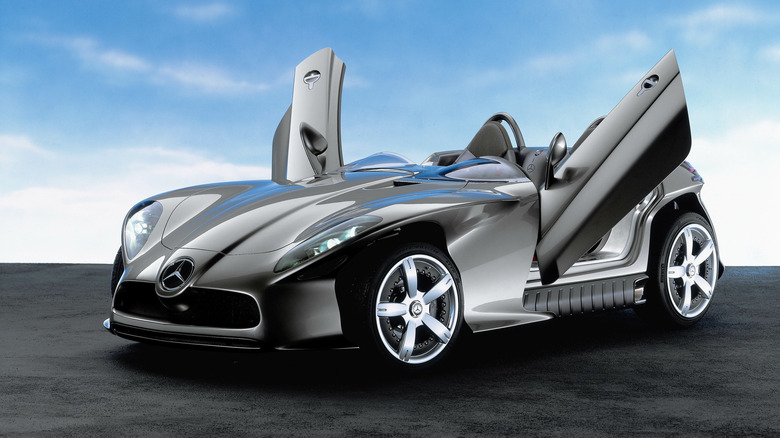This Strange-Looking Mercedes Concept Could Camber Its Wheels On Command For Better Handling
The F 400 Carving research vehicle created by Mercedes-Benz looks like it could slice its way across the desert sands of Tatooine in a "Star Wars" movie, and had the cutting-edge driving assistance technology to do precisely that. Not all of Mercedes' concept cars can say that. In 2001, the German automaker showed off a concept car at the Tokyo Motor Show built explicitly to delve into the viability of an active camber control system with some unique tires (via Mercedes).
Mercedes likened the car's tire tilt feature to a snow skier "carving" (thus the name) their way down a wintery mountain slope. When the vehicle goes into a curve, the outer wheels automatically tilt inward by as much as 20 degrees to lean into the bend, which gives the car increased lateral support. When going straight, the camber adjusts back to its standard-setting (via Mercedes).
This was all achieved through an array of sensors that measured several constantly changing conditions, such as the road, the car's speed and acceleration, and even the yaw. The system would then send electronic signals to adjust the camber's directional tilt on the fly (via Mercedes).
The active camber control system was designed to increase stability and road adhesion, enhancing overall driving safety. But it might not have been such a big deal if it was the only unique feature of the F 400. Mercedes had enough foresight to pair it with a few other concepts that, when combined, took these interconnecting systems to a whole different level.
The Mercedes-Benz concept was built to carve a new path
The F 400 also had specially designed tires with asymmetrical contact surfaces. As the car slid into the turn and the wheels tilted accordingly, it ran on the "slightly rounded" inner treads made from a unique rubber composite that, according to Mercedes, improved its overall "friction coefficient." Basically, it had softer side walls that lent itself to better corning capabilities and, in turn, safety.
As the car drove straight down the road, with its wheels in their upright and locked positions, the F 400 road on the "normal" part of the tire laced with standard tread patterns, but could obtain high speeds while keeping the road noise to a minimum.
The final piece of the dynamic handling system puzzle was the Active Body Control (ABC) feature, which kept the car horizontal by changing the suspension and dampening, even at high speeds and in tight turns. Only when you combined all these features did you get something special. According to Mercedes, the F 400 attained a maximum lateral acceleration of 1.28 g, a nearly 30% performance increase over the then-current generation of sports cars.
While the F 400 didn't light people's fires or make them want to kick the oddly tilted tires, its Active Body Control feature and a version of active camber control — called Active Curve Tilting — would become hits later down the line.
